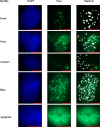Evaluation of machine learning models for automatic detection of DNA double strand breaks after irradiation using a γH2AX foci assay
- PMID: 32101565
- PMCID: PMC7043763
- DOI: 10.1371/journal.pone.0229620
Evaluation of machine learning models for automatic detection of DNA double strand breaks after irradiation using a γH2AX foci assay
Abstract
Ionizing radiation induces amongst other the most critical type of DNA damage: double-strand breaks (DSBs). Efficient repair of such damage is crucial for cell survival and genomic stability. The analysis of DSB associated foci assays is often performed manually or with automatic systems. Manual evaluation is time consuming and subjective, while most automatic approaches are prone to changes in experimental conditions or to image artefacts. Here, we examined multiple machine learning models, namely a multi-layer perceptron classifier (MLP), linear support vector machine classifier (SVM), complement naive bayes classifier (cNB) and random forest classifier (RF), to correctly classify γH2AX foci in manually labeled images containing multiple types of artefacts. All models yielded reasonable agreements to the manual rating on the training images (Matthews correlation coefficient >0.4). Afterwards, the best performing models were applied on images obtained under different experimental conditions. Thereby, the MLP model produced the best results with an F1 Score >0.9. As a consequence, we have demonstrated that the used approach is sufficient to mimic manual counting and is robust against image artefacts and changes in experimental conditions.
Conflict of interest statement
Faramarz Dehghani is editor of PLOS One. This does not alter our adherence to PLOS ONE policies on sharing data and materials.
Figures




Similar articles
-
FocAn: automated 3D analysis of DNA repair foci in image stacks acquired by confocal fluorescence microscopy.BMC Bioinformatics. 2020 Jan 28;21(1):27. doi: 10.1186/s12859-020-3370-8. BMC Bioinformatics. 2020. PMID: 31992200 Free PMC article.
-
Automatic detection of DNA double strand breaks after irradiation using an γH2AX assay.Histol Histopathol. 2018 May;33(5):475-485. doi: 10.14670/HH-11-945. Epub 2017 Nov 15. Histol Histopathol. 2018. PMID: 29139544
-
AutoFoci, an automated high-throughput foci detection approach for analyzing low-dose DNA double-strand break repair.Sci Rep. 2018 Nov 23;8(1):17282. doi: 10.1038/s41598-018-35660-5. Sci Rep. 2018. PMID: 30470760 Free PMC article.
-
DNA damage foci: Meaning and significance.Environ Mol Mutagen. 2015 Jul;56(6):491-504. doi: 10.1002/em.21944. Epub 2015 Mar 12. Environ Mol Mutagen. 2015. PMID: 25773265 Review.
-
Does gammaH2AX foci formation depend on the presence of DNA double strand breaks?Cancer Lett. 2005 Nov 18;229(2):171-9. doi: 10.1016/j.canlet.2005.07.016. Epub 2005 Aug 29. Cancer Lett. 2005. PMID: 16129552 Review.
Cited by
-
Assessment of Neuronal Damage in Brain Slice Cultures Using Machine Learning Based on Spatial Features.Front Neurosci. 2021 Oct 8;15:740178. doi: 10.3389/fnins.2021.740178. eCollection 2021. Front Neurosci. 2021. PMID: 34690679 Free PMC article.
-
HARLEY mitigates user bias and facilitates efficient quantification and co-localization analyses of foci in yeast fluorescence images.Sci Rep. 2022 Jul 18;12(1):12238. doi: 10.1038/s41598-022-16381-2. Sci Rep. 2022. PMID: 35851403 Free PMC article.
-
Ex vivo radiation sensitivity assessment for individual head and neck cancer patients using deep learning-based automated nuclei and DNA damage foci detection.Clin Transl Radiat Oncol. 2024 Jan 30;45:100735. doi: 10.1016/j.ctro.2024.100735. eCollection 2024 Mar. Clin Transl Radiat Oncol. 2024. PMID: 38380115 Free PMC article.
-
A deep learning model (FociRad) for automated detection of γ-H2AX foci and radiation dose estimation.Sci Rep. 2022 Apr 1;12(1):5527. doi: 10.1038/s41598-022-09180-2. Sci Rep. 2022. PMID: 35365702 Free PMC article.
References
-
- Sancar A, Lindsey-Boltz LA, Unsal-Kaçmaz K, Linn S, Ünsal-Kaçmaz K, Linn S. Molecular Mechanisms of Mammalian DNA Repair and the DNA Damage Checkpoints. Annu Rev Biochem. 2004;73(1):39–85. - PubMed
Publication types
MeSH terms
Substances
LinkOut - more resources
Full Text Sources
Research Materials

